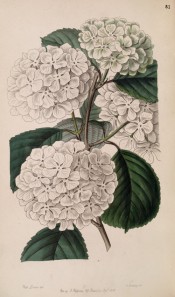Viburnum plicatum Thunb.
Likely to be the sterile garden form which was introduced by Robert Fortune some time before the wild form. It is a fully hardy, spreading, bushy, deciduous shrub with heart-shaped, toothed, deeply-veined leaves, to 10cm long, turning red-purple in autumn, and dense, spherical, terminal cymes, to 8cm across, of saucer-shaped, sterile white flowers, in spring. To 3m. [RHSE, Hortus, Hilliers’].
Horticultural & Botanical History
‘This, which is another of the plants procured for the Horticultural Society, is described in their Journal as a handsome deciduous bush, bearing some resemblance to the N. American Viburnum dentatum. The leaves are broad, coarsely serrate, somewhat plaited, dark green, narrowed to the base, and furnished with an abrupt point (cuspidate). The flowers are white, in round heads, of the size and with the appearance of the “double” Gueldres Rose. Mr. Fortune says that this plant is a native of the northern parts of the Chinese Empire, and was found cultivated in the gardens of the rich, by whom it was much admired. When full grown it forms a bush eight or ten feet high. It is a most profuse bloomer, forming numerous heads of snow-ball flowers, like the common Gueldres Rose. It will, doubtless, prove perfectly hardy in England; and, on account of its neat habit, will probably become a great favourite in our gardens.
This does not entirely agree with the account given by Siebold and Zuccarini, who speak of it thus:- “This Viburnum is one of the most beautiful plants that are cultivated in Japan. Its name, Satsuma Temari, indicates that it inhabits Satsuma, the most southern province of Kiusia (31 degrees N. L.); it was probably in the beginning imported from China. At the present time it is seen in every garden. Its balls of white sterile flowers give it the appearance of the Gueldres Rose; its habit, and broad oval plaited (crimped) leaves, are more like those of the Wayfaring Tree (Viburnum Lantana), but it only grows from four to six feet high.’ [BR f.51/1847]. Introduced into England in 1846 by Robert Fortune. [JD]. OFG 119/1854. IH pl.249/1860. FS pl.VI 10e Liv./1847.
History at Camden Park
Listed in the 1850 and 1857 catalogues [T.994/1850]. One of a number of plants received from Captain Simpson in late 1849 or early 1850, apparently on the same ship as those accompanying Captain P. P. King. The source is unclear. [ML A1980-3].
Notes
Viburnum plicatum A.Gray = Viburnum furcatum Blume ex Hook.f. & Thomson, a Japanese species introduced in 1892.
Published Jul 09, 2009 - 05:35 PM | Last updated Jul 16, 2010 - 02:12 PM
| Family | Caprifoliaceae |
|---|---|
| Category | |
| Region of origin | Probably of Chinese garden origin |
| Synonyms |
|
| Common Name | Japanese snowball bush |
| Name in the Camden Park Record |
Viburnum plicatum |
| Confidence level | high |


